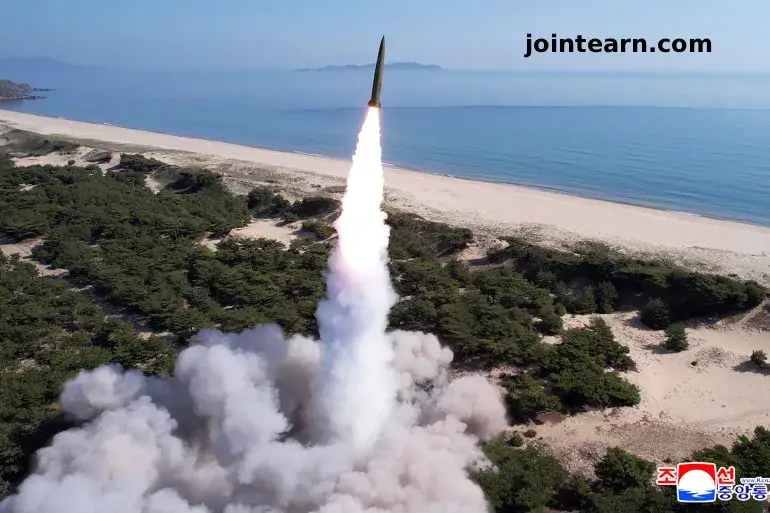
In a bold display of military defiance, North Korea has test-fired multiple short-range ballistic missiles just one week before world leaders gather in Gyeongju, South Korea, for the Asia-Pacific Economic Cooperation (APEC) summit. The move has sparked concerns among defense analysts that Pyongyang could stage further provocations to assert its nuclear ambitions on the global stage.
Missile Launch Ahead of High-Profile Global Meeting
South Korea’s Joint Chiefs of Staff (JCS) confirmed that the missiles, fired early Wednesday morning, were launched from an undisclosed location within North Korea and traveled approximately 350 kilometers (217 miles). Contrary to initial reports, the projectiles are believed to have landed inland, rather than in the East Sea (Sea of Japan).
“Our military has strengthened surveillance and is maintaining full readiness,” the JCS said in a statement, adding that intelligence sharing with the United States and Japan has been intensified to monitor further activity.
This marks North Korea’s first missile launch in five months, and notably, the first under South Korea’s newly elected President Lee Jae Myung, who took office in June 2025. The timing — just days before major international leaders arrive in South Korea — is being interpreted as a strategic move by Kim Jong Un to assert his regime’s influence.
Experts Warn of Further Provocations
Analysts have long predicted that Pyongyang could conduct missile tests before or during the APEC summit, where leaders including Chinese President Xi Jinping and US President Donald Trump are scheduled to attend.
Park Won-gon, a political science professor at Ewha Womans University in Seoul, told AFP that the timing is deliberate:
“This launch is Kim’s way of asserting his regime’s presence during an event hosted by Seoul, as he has done before. It’s a calculated political signal.”
Experts also warn that North Korea might use the global attention on South Korea to showcase its growing weapons capabilities and reinforce its status as a nuclear-armed state, despite UN sanctions prohibiting such tests.
New Hwasong-20 ICBM Signals Growing Nuclear Ambition
Earlier this month, Kim Jong Un unveiled what North Korean state media described as the country’s most powerful intercontinental ballistic missile (ICBM) — the Hwasong-20 — during a massive military parade marking the 80th anniversary of the ruling Workers’ Party. The event in Pyongyang was attended by senior officials from China, Russia, and other allied nations.
The display served as a symbolic message of North Korea’s expanding military capabilities and its strategic alliances in the face of growing isolation from Western powers.
“North Korea continues to invest in its nuclear weapons program to ensure regime survival and international leverage,” said a defense expert from Seoul’s Korea Institute for Defense Analyses (KIDA).
Pyongyang’s Strategic Message to the West
Despite facing crippling economic sanctions, Pyongyang continues to reject international pressure to abandon its weapons program. The regime insists that its missile development is a defensive measure against potential aggression from the United States and South Korea.
Kim Jong Un has expressed a conditional openness to future talks with former US President Donald Trump, who previously met Kim in June 2019 at the Demilitarized Zone (DMZ). However, Pyongyang has reiterated that its nuclear arsenal is non-negotiable.
“Our nuclear deterrent is essential to maintaining peace and sovereignty,” a statement from North Korea’s Foreign Ministry said earlier this month.
The statement echoes Kim’s broader diplomatic strategy — combining aggressive military posturing with controlled diplomatic engagement — to maintain international relevance and internal stability.
Regional and Global Reactions
Neighboring countries have responded with alarm.
The Japanese government convened an emergency security meeting, emphasizing that “North Korea’s continued missile tests pose a grave threat to regional stability.” Meanwhile, Washington reaffirmed its “ironclad commitment” to defending South Korea and Japan under its extended nuclear deterrence framework.
South Korean President Lee Jae Myung condemned the missile launches, calling them “a reckless provocation aimed at destabilizing the Korean Peninsula.” He urged Pyongyang to “cease all hostile actions and return to dialogue.”
Heightened Security Ahead of APEC Summit
As the APEC summit approaches, Seoul has ramped up security across major venues and transport hubs. The meeting, expected to draw 21 member economies, will focus on trade, innovation, and regional cooperation — but North Korea’s actions threaten to overshadow the agenda.
Diplomatic observers suggest that Kim’s strategy may be aimed at diverting international attention from internal economic woes while projecting power on the world stage.
“By testing missiles now, North Korea is reminding the world that it cannot be ignored,” said a former South Korean diplomat. “It’s both a show of strength and a political message.”
Conclusion: A Familiar Pattern of Power Play
North Korea’s latest missile launches come at a politically sensitive moment for the Asia-Pacific region. With the APEC summit offering a rare platform for US-China diplomacy, Pyongyang’s provocations could complicate international efforts toward peace and stability on the Korean Peninsula.
As analysts watch for possible additional tests during or after the summit, the missile launches reinforce a familiar pattern: Kim Jong Un’s regime using moments of global attention to assert its nuclear deterrence and demand recognition as a legitimate nuclear power.


Leave a Reply